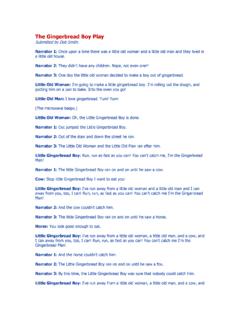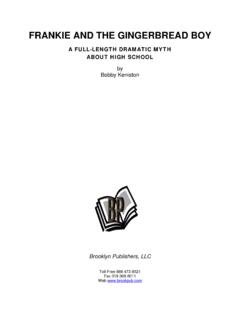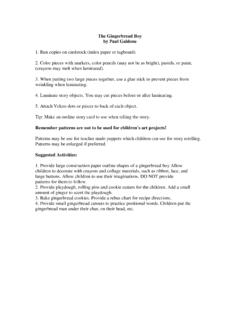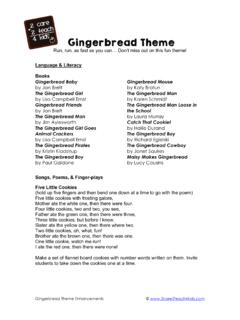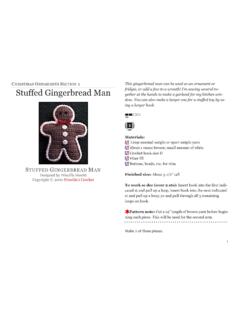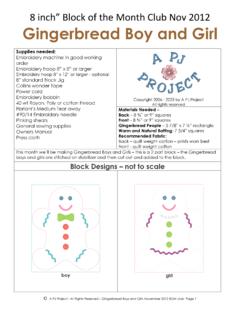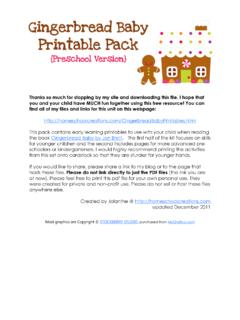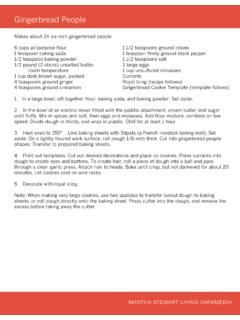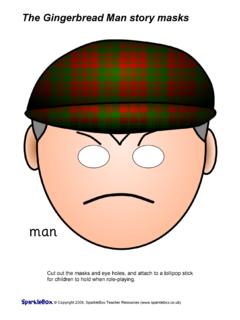Transcription of The Cajun Cornbread Boy - pelicanpub.com
1 The Cajun Cornbread Boy Educator s Guide Page 1 of 9 Dianne de Las Casas * * Marita Gentry * * The Cajun Cornbread Boy An Educator s Guide A Picture Book by Dianne de Las Casas Illustrated by Marita Gentry Pelican Publishing Company 2009 About the book "Dianne de Las Casas mixes humor, high spirits, lively narration and a colorful setting to bring alive the timeless tale of The gingerbread Boy (always a favorite of mine as a child). When a lonely old woman decides to cook up a Cornbread boy in her magic skillet, her too-generous use of cayenne pepper in the batter brings about unexpected results and sets the stage for this droll, Cajun -spiced retelling.
2 The author mixes her storyteller's ear for concise, vivid description; rhythmic language; and exciting pacing, with tasty dollops of humor, as she recounts the Cornbread boy's meetings with various woodland creatures who want to gobble him up. But the storyteller here gives the 'tragicomic' tale a suitably happy -- and logical -- ending brought about by that 'extra big dash of cayenne' in the hero's makeup. This delectable, delightful retelling is accompanied by lively, appealing watercolor illustrations by Marita Gentry that capture the zest of the tale and the distinctive bayou setting.
3 A pronouncing glossary of Cajun words and phrases, an author's source note, and a mouthwatering recipe for southern Cornbread , help make this marvelous book what they would call on the bayou a thing delish!" -- Robert D. San Souci, author of The Talking Eggs: A Folktale from the American South and Little Pierre: A Cajun Story from Louisiana About the Author Dianne de Las Casas is a celebrated author, award-winning storyteller and recording artist. Her CDs Jump, Jiggle & Jam and World Fiesta have been named Audio of the Week by School Library Journal. She performs arts-in-education programs and residencies at schools, libraries, festivals, museums, and special events and is a frequent presenter at the International Reading Association, American Library Association, and other literary and education conferences.
4 Dianne loves food spiced with delicious flavor and is always running after new recipes. She lives with her family in the New Orleans area. About the Illustrator Marita Gentry is a professional artist and has her own painting and teaching studio, Studio Marita, in Southern Louisiana. Her vivid illustrations have earned her numerous awards and commissions. An accomplished teacher, she is involved in several artist-in-residence programs each year, helping schools enliven their walls with magnificent murals. While her illustrations are inspired by the wildlife around her, Marita is careful not to chase after too many artful alligators.
5 The Cajun Cornbread Boy Educator s Guide Page 2 of 9 Dianne de Las Casas * * Marita Gentry * * Interview with the Author, Dianne de Las Casas How did you come up with the idea for The Cajun Cornbread Boy? Several years ago, a teacher asked me to write a play for her class to perform at a special presentation in Washington, I came up with a twist on the traditional tale of The gingerbread Boy, one of my favorite childhood stories. My stepdad is Cajun and I live in the New Orleans area, so I am very inspired by Cajun and Creole cuisine, as well as the rich culture. The book combines my two favorite things in the world: stories and food!
6 The teacher ended up not using The Cajun Cornbread Boy so I added it to my storytelling, spicing up my repertoire. It has been one of my most popular tales. What advice do you have for young authors? Step 1: Read! Explore the world around you through the power of words. Read as much as you can both fiction and non-fiction. The more you know about the world, the more you have to write about. Step 2: Write! Keep a journal and jot down your thoughts and ideas. Play with words don t be afraid to make up new ones. My two favorite children s authors, Roald Dahl (Charlie and the Chocolate Factory) and Dr.
7 Seuss (Green Eggs & Ham) were masters of word confabulation. Here are a few of my favorite made-up words and phrases: Cotton-headed ninny muggins (meaning fool ) From the movie, Elf, starring Will Ferrell Muggles (meaning non-magical folk ) From the Harry Potter book series by Rowling Jabberwocky (meaning non-sense talk ) From Jabberwocky, a poem by Lewis Carroll Frindle (meaning pen ) From Frindle by Andrew Clements Fizzwiggler (meaning mean person ) from The BFG by Roald Dahl Zizzer-Zazzer-Zuzz (a made-up animal) from Dr. Seuss s ABC Interview with the Illustrator, Marita Gentry What inspires you as an artist?
8 I am inspired by everyday life and the things I see around me such as animals, my cats, my garden, and my family. Animals as well as people provide great facial expressions through their thoughts and actions. When I worked on the paintings for The Cajun Cornbread Boy, I went to the dark and beautiful Bayou Manchac to take pictures of the surroundings and wildlife. The cypress trees in the book came from pictures taken at Chico State Park. I am also inspired by my memories. The old woman in the story is a combination of little old ladies from my childhood as well as my own grandmothers.
9 The scarf on the old lady s head was inspired by the farmer lady who sold milk to my family when I was a little girl. Art is everywhere. Just take a look around. The Cajun Cornbread Boy Educator s Guide Page 3 of 9 Dianne de Las Casas * * Marita Gentry * * What advice do you have for young artists? Draw, draw, draw! Draw things you find around you. Draw what you see. Your art does not have to be realistic. Be okay with your own style. Don t be afraid to stray outside of the lines. You have to learn to break boundaries to really draw. It is also important to use your time in school to learn what you can. Art is about reading, math, and social studies.
10 Reading makes your imagination more vivid. You have to be aware of the world around you to draw it. Language Arts Word Whizzling (Dianne s made-up word for finding new words in another word or phrase) How many words can you whizzle from Cornbread ? The words have to be 3 or more letters. We found 50 words but there are more! _____ _____ _____ _____ _____ _____ _____ _____ _____ _____ _____ _____ _____ _____ _____ _____ _____ _____ _____ _____ _____ _____ _____ _____ _____ _____ _____ _____ _____ _____ _____ _____ _____ _____ _____ _____ Twisted Tales Writing Exercise The Cajun Cornbread Boy is a twist on the traditional tale of The gingerbread Boy.

